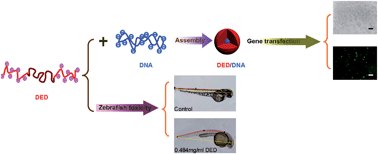Influence of block sequences in polymer vectors for gene transfection in vitro and toxicity assessment of zebrafish embryos in vivo†
Abstract
In this study, a

* Corresponding authors
a
The Key Laboratory of Bioactive Materials, Ministry of Education, College of Life Science, Nankai University, Tianjin, China
E-mail:
xzfeng@nankai.edu.cn
b
Department of Physiology, School of Medicine, Nankai University, Tianjin, China
E-mail:
leili@nankai.edu.cn
c
National Center for Nanoscience and Technology, Beijing, PR China
E-mail:
yangyl@nanoctr.cn
In this study, a

 Please wait while we load your content...
Something went wrong. Try again?
Please wait while we load your content...
Something went wrong. Try again?
Y. Yao, D. Feng, Y. Wu, Q. Ye, L. Liu, X. Li, S. Hou, Y. Yang, C. Wang, L. Li and X. Feng, J. Mater. Chem., 2011, 21, 4538 DOI: 10.1039/C0JM03728A
To request permission to reproduce material from this article, please go to the Copyright Clearance Center request page.
If you are an author contributing to an RSC publication, you do not need to request permission provided correct acknowledgement is given.
If you are the author of this article, you do not need to request permission to reproduce figures and diagrams provided correct acknowledgement is given. If you want to reproduce the whole article in a third-party publication (excluding your thesis/dissertation for which permission is not required) please go to the Copyright Clearance Center request page.
Read more about how to correctly acknowledge RSC content.
 Fetching data from CrossRef.
Fetching data from CrossRef.
This may take some time to load.
Loading related content
